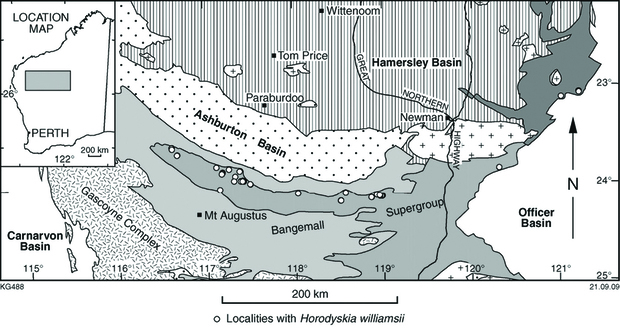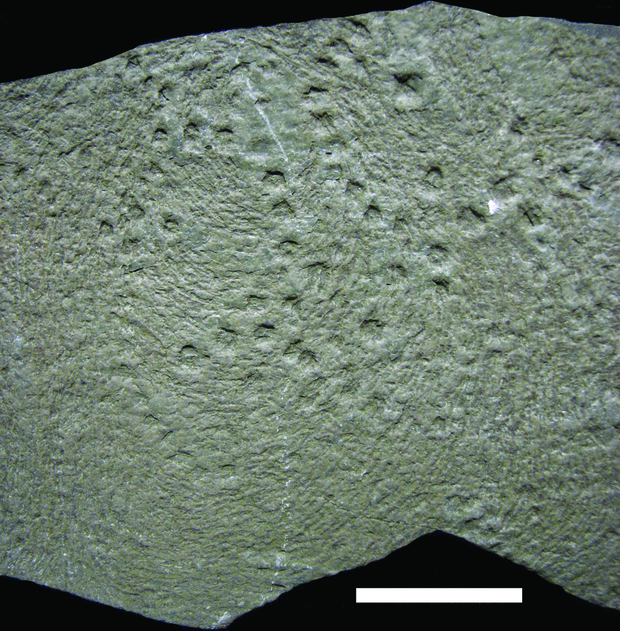The ‘strings of beads’, named Horodyskia williamsii by Grey and others in 2010, are an enigmatic and iconic Western Australian fossil found in the southern Pilbara and northern Mid West regions. Found in rocks between 1171 and 1070 million years old, they likely represent the oldest evidence for multicellular life in Western Australia. However, their origin remains debated.
‘Strings of beads’ — indications of early multicellular life?
‘Strings of beads’ (also known as ‘chain of beads’) were first identified in 1982 by geologist Robert Horodyski (University of Tulane) from outcrops in Glacier National Park, Montana, US. Calling them ‘problematic bedding-plane markings’, Horodyski described the features fully, and used their characteristics to carefully weigh the possibilities of whether they were formed by organic or inorganic processes. After this discovery, similar forms began to be described from other parts of the world, including India, China, and Australia (Western Australia and Tasmania). Most of these records are Mesoproterozoic in age, with the oldest records being those in Montana (~1480 million years old) and Tasmania (1450 to 1330 million years old).
‘Strings of beads’ were first collected in Western Australia in 1985 by Geological Survey of Western Australia (GSWA) geologist Ian Williams. Although at first found exclusively within sandstones of the Stag Arrow Formation, Collier Basin, the ‘beads’ were later also observed in the age-equivalent Backdoor Formation in the same basin. Although poorly constrained, both of these units are considered Mesoproterozoic in age. The ‘strings of beads’ are relatively plentiful in both of these units, and have been recorded from at least 49 separate localities; GSWA holds an extensive collection of ‘strings of beads’ from numerous sites in its Paleontology Collection.
Shape, size, and form
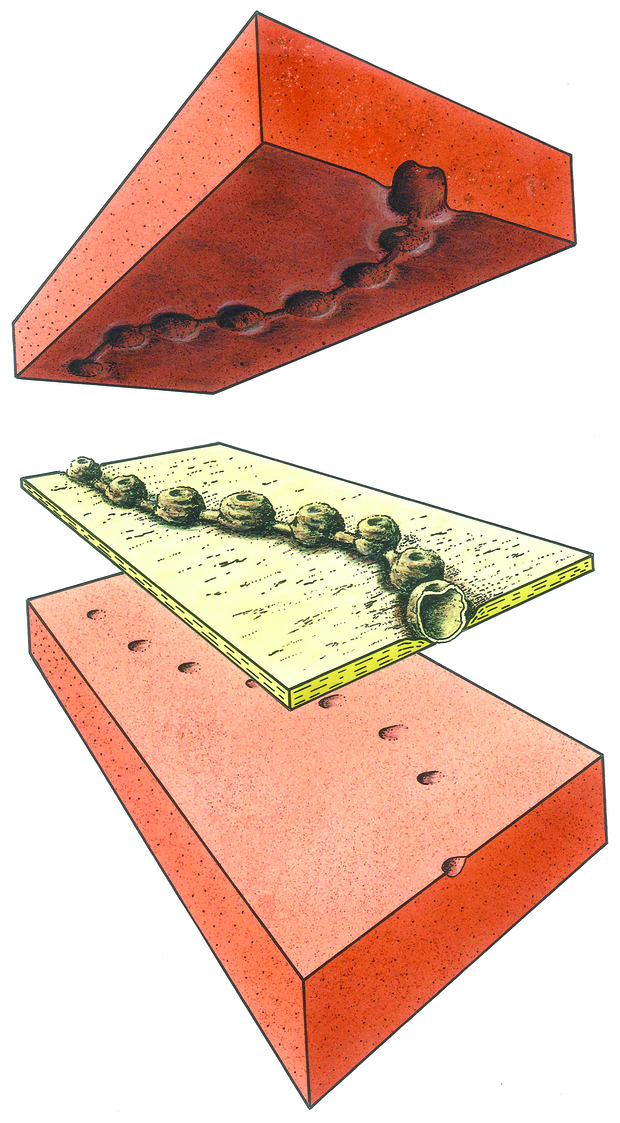
In Western Australia, the sandstones in which the ‘beads’ are preserved tend to be reddish-brown in colour. However, in certain areas, the rock can be greenish, with a distinctive microbial texture formed by a layer of benthic (seafloor) bacterial mat, which is thought to have grown over the ‘strings of beads’ and helped preserve them. An interesting feature of the ‘strings of beads’ are that they are mostly preserved on the underside of the sandstone bed, with only rare representatives seen on upper rock bed surfaces. Therefore, the impressions seen are of the organism’s upper surface, with the fossil itself worn away after the rock hardened around it.
The Western Australian ‘strings of beads’ are preserved as lines of small, round impressions. The strings can be of variable length (3 to 30+ beads), often curve and overlap, but never branch. Beads are 1–4 mm in diameter and rounded to subrounded in shape. Within an individual string, the beads are consistent in size (i.e. all beads in a single chain are around 1 mm in diameter, or around 4 mm diameter) and regularly spaced. In the best-preserved examples, the beads are seen to be connected to one another by a thin (~0.2 mm wide) ‘thread’, which is also preserved as an impression. Where a thread is seen, the beads always sit at the centre, rather than ‘budding’ off the side. Some of the bead impressions preserve a central raised ‘pimple’, surrounded by a deeper rim; this feature is thought to indicate that the beads were hollow or filled with a material softer than the sphere wall, with the overlying sediment weight depressing the spheres at the top, and therefore forming a ‘pimple’ in the negative-relief impressions.
Also found in association with ‘strings of beads’ are dimple marks, which are single, randomly distributed negative-relief features of various shapes, but commonly star shaped, elongate or conical. Although it has been suggested that ‘strings of beads’ are connected by a thread to these dimple marks, none of the known examples show this unambiguously.
The ‘strings of beads’ are preserved in a range of marine environments, suggesting either that the organism was a generalist living in a wide number of conditions, or that some ‘beads’ were transported from their origin point after death.
Animal, vegetable, or mineral?
The age and simple form of these impressions have led to extensive debate over whether the traces are biogenic (formed by living organisms), or whether they are pseudofossils created by the action of environmental factors. When first described in 1982, Horodyski could not decide if they were formed by organisms and so designated them ‘dubiofossils’ of probable inorganic origin. However, with additional evidence from new material uncovered worldwide, general scientific consensus has shifted toward considering these features body fossils.
Reconstructions and interpretations for the ‘strings of beads’
There have been numerous suggestions of inorganic processes that could form the ‘strings of beads’, including current (‘sole’ or ‘tool’) marks, rain drop prints, crystal growths and mineral grain trails. Most of the problems with these interpretations relate to the regularly spaced, rounded, statistically similar sized impressions seen in the ‘strings of beads’, a level of regularity that is virtually never observed in inorganic structures. Crystal growths tend to be singular, not linearly aligned, and both these growths and those in mineral trails are usually irregularly shaped and randomly spaced. Further, current marks would always be expected to be aligned with the water flow directions in the rocks, which is not the case for the ‘strings of beads’.
An additional problem of relief also exists for inorganic surface impressions. Although rain drop prints might form shapes superficially similar to the ‘strings of beads’, being rounded, with a depressed rim and raised central pimple, they only form negative relief on the top surface of a bed; on a bottom surface of a bed, where many of the ‘strings of beads’ are preserved, they would always form features of positive relief. Conversely, the bead examples preserved on the top bedding surfaces do not preserve the rims or dimples seen in a rain print. This question of preserved relief also precludes the ‘strings of beads’ as being interpreted as a number of types of trace fossils, such as walking trails, and sediment-surface feeding trails.
The consistency and regularity seen in the ‘strings of beads’ have therefore been used as one of the main arguments that the features were formed by an organism. Suggestions have included trace fossils such as faecal pellets or burrows, and body fossils of algae, fungi, primitive animals, or other unknown multicellular organisms. A lack of sediment disturbance surrounding the Western Australian beads (caused by animals burrowing or moving through the sediment) would suggest that the ‘strings of beads’ are not trace fossils, supported by the idea that such burrows and faecal trails would be unlikely to be as regularly arranged as the ‘beads’. This is further supported by the discovery of a complex internal structure within the Horodyskia specimens from the US, although this structure has not been confirmed for the Western Australian examples.
As a result, Horodyskia is generally considered to represent a body fossil, although there is still no consensus on what type of organism the fossils represent. Suggestions that possibly connected variously shaped dimple features seen alongside Horodyskia williamsii are holdfasts of some kind, tethering the ‘strings of beads’ to the sediment surface, would indicate a link to sessile animals or seaweeds. However, there is no unambiguous evidence that the strings are in fact attached to the dimple features, and the dimples have not been noted in association with Horodyskia from Montana.
Therefore, the ‘string of beads’ fossils remain a fascinating but mysterious form of past life. As research continues on these fossils, it is hoped that the identity of the forms will be elucidated in time.
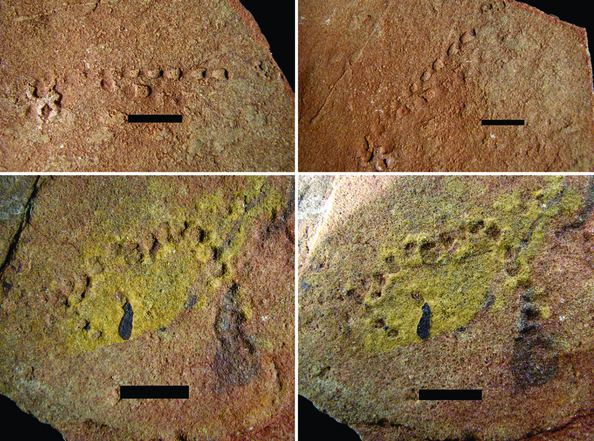
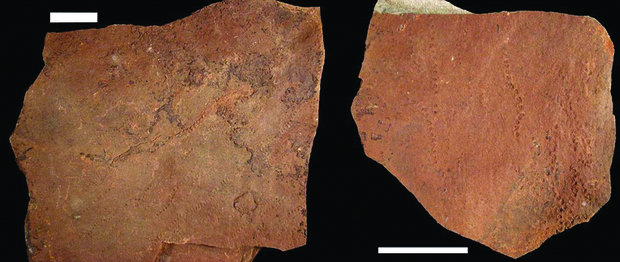
Western Australian fossil law
In Western Australia, fossicking and fossil collecting is permitted under the following conditions:
- collectors first obtain a Miner’s Right from the Department of Mines, Industry Regulation and Safety (DMIRS)
- written permission has been granted when collecting on people’s property or pastoral leases
- no collecting is to be made on Crown Reserves (e.g. National Parks, State Forest areas, regulated Geoheritage Reserves) without prior written approval from the relevant State or Federal Government agencies. The only exceptions to this are those State Reserves listed as having a Common, Public Utility or Mining purpose.
All collectors are encouraged to bring interesting fossils to either GSWA or the Western Australian Museum for identification. Understanding what fossils are found and where helps scientists better understand the geology of the State and helps government correctly identify and regulate important fossil sites for future generations.
It should be remembered that any Australian fossils sent overseas (even for non-commercial purposes) are subject to Federal Heritage laws. See the Federal Moveable cultural heritage website for more information.
Many of the fossils discussed here, including the Trendall locality ‘egg carton’ stromatolites, can be seen in the Western Australian Museum’s Origins gallery.
More information
- http://www.utas.edu.au/latest-news/utas-homepage-news/prehistoric-minerals-from-tasmanias-oldest-rocks-establish-western-north-america-and-tasmania-were-once-neighbours
- Grey, K and Williams, IR 1990, Problematic bedding-plane markings from the Middle Proterozoic Manganese Subgroup, Bangemall Basin, Western Australia: Precambrian Research, vol. 46, p. 307–327, doi:10.1016/0301-9268(90)90018-L
- Grey, K, Williams, IR, Martin, DMcB, Fedonkin, MA, Gehling, JG, Runnegar, BN and Yochelson, EL 2002, New occurrences of ‘strings of beads’ in the Bangemall Supergroup: a potential biostratigraphic marker horizon: Geological Survey of Western Australia, Annual Review 2000–01, p. 69–73.
- Grey, K, Yochelson, EL, Fedonkin, MA and Martin, DMcB 2010, Horodyskia williamsii new species, a Mesoproterozoic macrofossil from Western Australia: Precambrian Research, vol. 180, p. 1–17, doi: 10.1016/j.precamres.2010.02.006.
- Horodyski, RJ 1982, Problematic bedding-plane markings from the Middle Proterozoic Appekunny Formation, Belt Supergroup northwestern Montana: Journal of Paleontology, vol. 56, p. 882–889.
- Retallack, GJ, Dunn, KL and Saxby, J 2013, Problematic Mesoproterozoic fossil Horodyskia from Glacier National Park, Montana, USA: Precambrian Research, vol. 226, p. 125–142, doi: 10.1016/j.precamres.2012.12.005.
- Vickers-Rich, P and Fedonkin, MA 2007, The Background. The Proterozoic (2.5 billion to 542 million years ago) in MA Fedonkin, JG Gehling, K Grey, GM Narbonne and P Vickers-Rich (eds), The Rise of animals: evolution and diversification of the Kingdom Animalia: John Hopkins Press, Baltimore, Maryland, p. 29–45.
More information on fossils and paleontological data within GSWA
External links covering a range of topics relating to Australian fossils, paleontology and geological time can be found on External websites
Contact
For more information contact:
paleontology@dmirs.wa.gov.au

